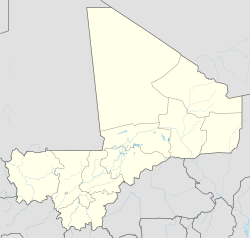Timbuktu
Timbuktu | |
|---|---|
 Djingareiber Mosque, Timbuktu | |
| Coordinates: 16°46′24″N 2°59′58″W / 16.77333°N 2.99944°W | |
| Country | |
| Region | Tombouctou Region |
| Cercle | Timbuktu Cercle |
Timbuktu is a city in Tombouctou Region, Mali. Sankore University and other madrasas are in the city. The city was important for thinking and for religion in the 15th and 16th centuries. It was important in spreading Islam through Africa at that time. There are three great mosques: Djingareyber, Sankore and Sidi Yahya. They are reminders of Timbuktu's golden age. They are always being fixed, but are threatened because the desert is spreading.[1]
Songhay, Tuareg, Fulani, and Mandé people live in Timbuktu. It is about 15 km north of the Niger River. There is a route across the Sahara Desert from east to west and this is used for trade. There is another from north to south. These two routes meet in Timbuktu. It is an entrepôt for rock salt from Taoudenni. This means that the salt is brought here and sold to other people to take it somewhere else, but no tax is charged.
Its location helped different people meet, so local people, Berbers and Arabs met here. It has a long history of mixed African trade, so it became famous in Europe for this reason. Therefore, western people often thought of Timbuktu as being exotic. It has a hot desert climate (BWh in the Koeppen climate classification).
Timbuktu has given a lot of research and study to Islam and to the world.[2] Important books were written and copied in Timbuktu in the 14th century. This made the city become the center of writing in Africa.[3]
References
[change | change source]- ↑ Timbuktu — World Heritage (Unesco.org)
- ↑ Timbuktu. (2007). Encyclopædia Britannica. Chicago: Encyclopædia Britannica.
- ↑ Okolo Rashid. Legacy of Timbuktu: Wonders of the Written Word Exhibit - International Museum of Muslim Cultures[1] Archived 2009-02-09 at the Wayback Machine


